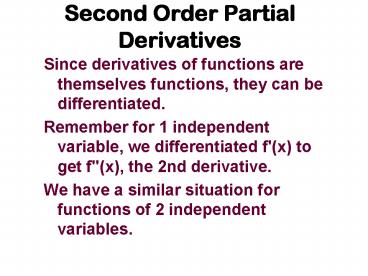Second Order Partial Derivatives - PowerPoint PPT Presentation
1 / 22
Title:
Second Order Partial Derivatives
Description:
The figure shows tangent lines with slope fy on the surface of f(x, ... to a local extrema, the contour lines get closer and closer together until what happens? ... – PowerPoint PPT presentation
Number of Views:349
Avg rating:3.0/5.0
Title: Second Order Partial Derivatives
1
Second Order Partial Derivatives
- Since derivatives of functions are themselves
functions, they can be differentiated. - Remember for 1 independent variable, we
differentiated f'(x) to get f"(x), the 2nd
derivative. - We have a similar situation for functions of 2
independent variables.
2
Second Order Partial Derivatives
- We have a similar situation for functions of 2
independent variables. - You have seen that the partial derivatives of
functions are also functions. So we
differentiate them. However, since the 1st
partial derivative can be a function of both
independent variables, we have more possible 2nd
derivatives.
3
Second Order Partial Derivatives
- If z f(x,y), then we find
- How many ways can we differentiate fx??
4
Second Order Partial Derivatives
- If z f(x,y), then we find
- How many ways can we differentiate fx??
- Since fx is a function of x and y, we may find
partial derivatives with respect to both x and y!
5
Second Order Partial Derivatives
- If z f(x,y), then we find
- Since fx is a function of x and y, we may find
partial derivatives with respect to both x and y!
6
Second Order Partial Derivatives
- If z f(x,y), then we find
- Since fy is a function of x and y, we may find
partial derivatives with respect to both x and y!
7
Second Order Partial Derivatives
- Remember 2nd derivatives from Calculus 1?
- What did they tell us about a function of 1
independent variable??
8
Second Order Partial Derivatives
- The 2nd derivative tells us about the curvature
of the f(x). If f"(x)gt0 near a point, what do we
know?? - If f"(x)gt0 in an interval around x, the function
is concave up on that interval. - If f"(x)lt0 in an interval around x, the function
is concave down on that interval.
9
Second Order Partial Derivatives
- If f"(x)gt0 in an interval around x, the function
is concave up on that interval. - If f"(x)lt0 in an interval around x, the function
is concave down on that interval. - Can you carry these ideas over for fxx and fyy?
10
Second Order Partial Derivatives
- fxx determines the curvature of f(x,y) in a
constant y plane. - The figure shows tangent lines with slope fx on
the surface of f(x,y) on the plane yb.
11
Second Order Partial Derivatives
- fyy determines the curvature of f(x,y) in a
constant x plane. - The figure shows tangent lines with slope fy on
the surface of f(x,y) on the plane xa.
z
y
(a,b,0)
x
12
Second Order Partial Derivatives
- What about the mixed derivatives, fxy and fyx?
- The figure shows tangent lines with slope fx
varying with y. - fxy tells us how the slope, fx, varies with y.
z
(a,b,0)
y
x
13
Second Order Partial Derivatives
- What about the mixed derivatives, fxy and fyx?
- The figure shows tangent lines with slope fy
varying with x. - fyx tells us how the slope, fy, varies with x.
z
y
(a,b,0)
x
14
Second Order Partial Derivatives
- Examples Find all 2nd partial derivatives
- a)
- b)
- c)
15
Local Extrema
- Remember again from Calculus 1 and 2 for
functions of 1 independent variable how you found
local extrema. - What is the difference between global and local
extrema? - What were the tests you can use to determine
local extrema?
16
Local Extrema
- Recall
- f has a local maximum at the point Po, if
f(Po)?f(P) for all point P near Po. - f has a local minimum at the point Po, if
f(Po)?f(P) for all point P near Po. - What do we mean by critical points of a function
of 1 variable, f(x)? - How do we find critical points for f(x)?
17
Local Extrema
- Recall
- f has a local maximum at the point Po, if
f(Po)?f(P) for all point P near Po. - f has a local minimum at the point Po, if
f(Po)?f(P) for all point P near Po. - How will these ideas translate for f(x,y)??
18
Local Extrema
- Recall
- f has a local maximum at the point Po, if
f(Po)?f(P) for all point P near Po. - f has a local minimum at the point Po, if
f(Po)?f(P) for all point P near Po. - The gradient of f serves the same function for
f(x,y) as f'(x) did for x. - Recall that grad f points in the direction of
greatest increase of f. What does this mean if
Po is a local max?
19
Local Extrema
- Examine Fig 14.1 and 14.2 pg 176.
- You can see the local maxima and minima in Fig.
14.1. How do they appear in the contour diagram
in Fig 14.2?? - Can you see as you get closer and closer to a
local extrema, the contour lines get closer and
closer together until what happens?
20
Local Extrema
- The condition for finding the critical points is
for - For grad f to be zero, what must be true?
21
Local Extrema
- The condition for finding the critical points is
for - For grad f to be zero, what must be true?
- This means that each partial derivative must be
zero. - Example 1,2 pg 177-178. Note how the local
min/max are found.
22
Local Extrema
- The condition for finding the critical points is
for - Find the critical points of the function































